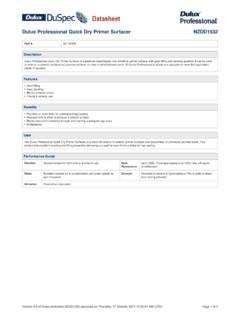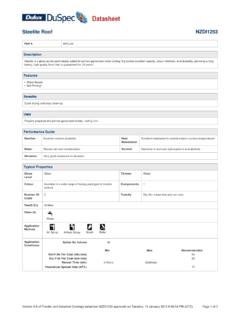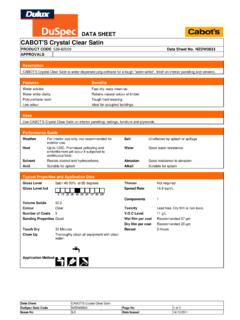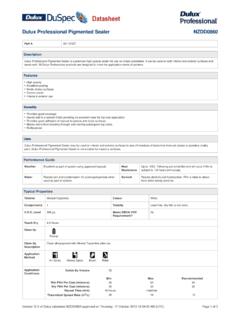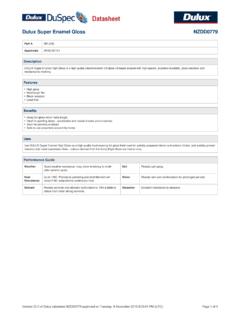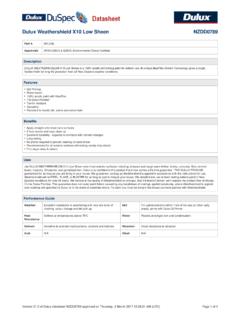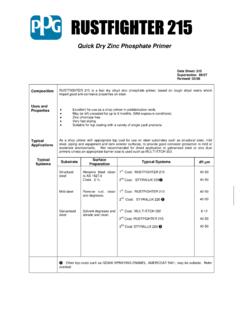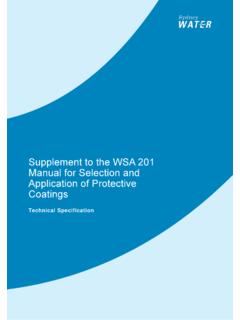Transcription of Dulux Duremax GPE Zinc Phosphate NZDI0897 - …
1 Dulux Duremax GPE zinc Phosphate NZDI0897 . Description Dulux Duremax GPE zinc Phosphate - General Purpose Epoxy zinc Phosphate primer Features And Benefits Excellent Durability Suitable for a wide range of environments Ease of Application Can be applied by brush, roller or spray methods Anti-corrosive Pigmentation Provides excellent corrosion protection Good abrasion resistance Provides superior edge protection High build formulation Uses Duremax GPE zinc Phosphate has been locally developed specially for Australasian conditions using the latest epoxy technology. It is a general purpose epoxy zinc Phosphate primer used on mild steel. Duremax GPE zinc Phosphate is a high performance coating for the protection of structures exposed to severe environments such as chemical plants, offshore platforms, refineries, shiploaders, coal wash plants etc.
2 Duremax GPE zinc Phosphate is suitable for fresh and salt-water immersion when suitably topcoated. It is compatible over inorganic zinc and epoxy primers and can be topcoated with a wide range of coating types. Performance Guide Weatherability Some chalking/yellowing will occur on exposure. This Salts Excellent resistance to neutral and alkali salts. won't detract from the resistance properties. Heat Up to 120 C dry heat. Water Excellent resistance to immersion in fresh and salt water Resistance when suitably topcoated. Solvents Resists splash/spillage of most hydrocarbon solvents, Abrasion Good when fully cured. refined petroleum products and most common alcohols. Acids Suitable for splash and spillage of mild acids. Alkalis Suitable for splash and spillage of strong alkali. Typical Properties Finish Semi Gloss Colour Grey (Approximate Match to AS2700 N33 Lightbox Grey).
3 Components 2 Pot Life 3 4 hours @ 25 C. Shelf Life 12 months minimum @ 25 C Mixing 4 pt A : 1 pt B by volume Ratio (V/V). Thinner Prothinner 400 (965-63021) Suitable Blast cleaned steel. Prepared concrete, aluminium and Substrates galvanised steel Line/Shade 780-52033 (Part A). 976-84577 (Part B). Application Methods Air Spray Airless Spray Brush Roller Application Min Max Conditions Air Temperature 10 45. Substrate Surface Temperature 10 45. Relative Humidity 0 85. Solids By Volume 71. Min Max Recommended Wet Film Per Coat (microns) 174. Dry Film Per Coat (microns) 125. Recoat Time (min) 8 Hours 4 Weeks*. Theoretical Spread Rate (m2/L) Hardener Details Version of Protective Coatings datasheet NZDI0897 approved on Monday, 30 January 2012 8:09:45 AM (UTC) Page 1 of 4. STANDARD. Hardener Title HARDENER.
4 Coating Thickness (microns) Application Conditions ( C). Min Max Recommended Min Max Wet Film per Coat 175 Air Temp. 10 45. Dry Film per Coat 125 Substrate Surface Temp. 10 45. Relative Humidity 0 85. Concrete Moisture Content 3-4 Hours (4L, Solids By Volume 71 Level <330 g/L Pot Life 25C). # Drying characteristics at 125 microns dry film thickness Temperature Humidity Touch Handle Full Cure Recoat Min Recoat Max 10 C 50% 16 Hours 28 Hours 7 Days 28 Hours 4 Weeks 15 C 50% 12 Hours 20 Hours 7 Days 20 Hours 4 Weeks 25 C 50% 4 Hours 10 Hours 7 Days 8 Hours 4 Weeks FAST CURE. Hardener Title HARDENER. Coating Thickness (microns) Application Conditions ( C). Min Max Recommended Min Max Wet Film per Coat 170 Air Temp. 5 45. Dry Film per Coat 125 Substrate Surface Temp. 5 45. Relative Humidity 0 85. Concrete Moisture Content Solids By Volume 72% Level <300 g/L Pot Life 2 Hours (4L, 25C).
5 # Drying characteristics at 125 microns dry film thickness Temperature Humidity Touch Handle Full Cure Recoat Min Recoat Max 5C 50% 9 Hours 18 Hours 7 Days 18 Hours 4 Weeks 10 C 50% 6 Hours 14 Hours 7 Days 14 Hours 4 Weeks 15 C 50% 5 Hours 10 Hours 7 Days 10 Hours 4 Weeks 25 C 50% Hours 6 Hours 7 Days 6 Hours 4 Weeks QUICKTURN. Hardener Title HARDENER. Coating Thickness (microns) Application Conditions ( C). Min Max Recommended Min Max Wet Film per Coat 175 Air Temp. 5 35. Dry Film per Coat 125 Substrate Surface Temp. 5 35. Relative Humidity 0 85. Concrete Moisture Content 90 Minutes (4L, Solids By Volume 72% Level <310 g/L Pot Life 25C). # Drying characteristics at 125 microns dry film thickness Temperature Humidity Touch Handle Full Cure Recoat Min Recoat Max 5C 50% 7 Hours 14 Hours 7 Days 14 Hours 4 Weeks 10 C 50% 5 Hours 9 Hours 7 Days 9 Hours 4 Weeks 15 C 50% 3 Hours 5 Hours 7 Days 5 Hours 4 Weeks 25 C 50% 90 Minutes 3 Hours 7 Days 3 Hours 4 Weeks Version of Protective Coatings datasheet NZDI0897 approved on Monday, 30 January 2012 8:09:45 AM (UTC) Page 2 of 4.
6 # TYPICAL SPREADING RATE AT RECOMMENDED DRY FILM BUILD # A spreading rate of meters per litre corresponds to 125 microns dry film thickness assuming no losses. Practical spreading rates will vary depending on such factors as method and condition of application and surface roughness Hardener These figures are given as a guide only, as ventilation, film thickness, humidity, thinning and other factors will influence the rate of drying. Section If the maximum overcoat interval is exceeded then the surface MUST be abraded to ensure maximum intercoat adhesion. Footer Use of fast or low temperature hardeners may result in increased yellowing and a reduction of gloss level. * When used for non-immersion conditions. Refer to PRECAUTIONS section for overcoating intervals and requirements for immersion service.
7 Surface Preparation Round off all rough welds, sharp edges and remove weld spatter. Remove grease, oil and other contaminants in accordance with For steel substrates, abrasive blast clean to a minimum of Class with a blast profile of 40-70 microns. For non-ferrous substrates whip blast. Immersed steel must be prepared to Class 3. Remove all dust by brushing or vacuum cleaning. Application Guide Application Stir each can thoroughly until the contents are uniform. Use of a power mixer is recommended. Mix the contents of both packs together Method thoroughly using a power mixer and allow to stand for 10 minutes. Remix thoroughly before using. Brush/Roller Apply even coats of the mixed material to the prepared surface. When brushing and rolling additional coats may be required to attain the specified thickness.
8 Conventional Thinning is not normally required, however a small amount (5% or less by volume) of Dulux Prothinner 400 (920-81942) can be added. Spray Typical Set-up Graco Delta Gun: Pressure at Pot: Pressure at Gun: (239543). 70-100 kPa (10-15 ). 380-415 kPa (55-60 ). Airless Standard airless spray equipment such as a Graco 45:1 Xtreme with a fluid tip of 17 21 thou ( ) and an air supply capable of Spray delivering 550-690 kPa (80 -100 psi) at the pump. Thinning is not normally required but up to 50ml/litre of Dulux Prothinner 400 may be added to ease application. Precautions This is an industrial product designed for use by experienced Protective Coating applicators. Where conditions may require variation from the recommendations on this Product Data Sheet contact your nearest Dulux representative for advice prior to painting.
9 Do not apply in conditions outside the parameters stated in this document without the express written consent of Dulux Australia. Freshly mixed material must not be added to material that has been mixed for some time. Do not apply at temperatures below 10 C when using Standard hardener or 5 C when using Fast Cure or Quickturn hardener. In hot weather use Dulux Epoxy Thinner (920 08925) for improved flow. Do not apply at relative humidity above 85% or when the surface is less than 3 C above the dewpoint. Do not use Quickturn hardener for immersion conditions. When used for immersion conditions the maximum overcoat interval is 3 days. The coating MUST be fully cured and solvent free prior to be placed under immersion conditions. For best results in water immersion conditions replace Dulux Prothinner400 with Dulux CR Reducer.
10 Do NOT use as a primer over galvanised steel when using Fast Cure hardener as delamination can occur. Use of fast or low temperature hardeners may result in increased yellowing and a reduction of gloss level. Clean Up Clean all equipment with Prothinner 400 (965-63021) immediately after use. Overcoating # Aged coating should be tested for lifting by a method suitable to the coating thickness, for example 'X' cut or crosshatch methods. If it lifts, remove it. The surface must be free of oil, grease and other contaminants. If the coating has exceeded the maximum recoat interval then abrade the surface. High-pressure water blast at 1,200 - 1,500 to remove loosely adhering chalk and dust. Version of Protective Coatings datasheet NZDI0897 approved on Monday, 30 January 2012 8:09:45 AM (UTC) Page 3 of 4.
